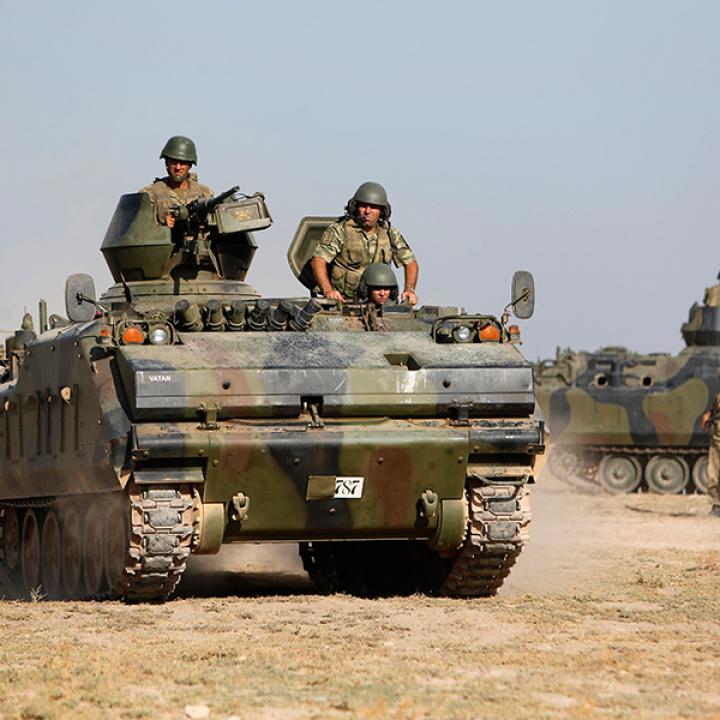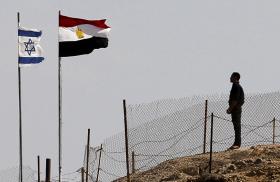

The Trump administration is implicitly backing Ankara’s policy imperatives for now, but its approval comes with an imminent expiration date that could arrive even sooner if the operation goes awry.
On October 9, Turkey launched its long-expected military operation into north Syria with the goal of undermining the Kurdish People’s Defense Units (YPG). Why did Ankara act now? What are the operation’s tactical objectives? And how does the decision fit into the Trump administration’s own objectives in Syria?
TURKEY’S MAIN DRIVERS
The YPG is an offshoot of the Kurdistan Workers Party (PKK), a group that has been fighting the Turkish government for decades and is designated as a terrorist entity by the United States and other NATO members. Turkey has never accepted the U.S. decision to ally with the YPG in the war against the Islamic State. Rather, President Recep Tayyip Erdogan tolerated the partnership until the last bits of the IS “caliphate” in Syria crumbled earlier this year, then began making plans for a military incursion.
In short, Ankara was bent on taking action, and constraining the operation may prove difficult going forward. To understand why, one need only look at two key domestic factors in Turkey:
Broad public resentment toward the PKK. The current operation is not “Erdogan’s war.” On most issues, Turkey remains polarized between two large camps, one opposing Erdogan and the other supporting him. Yet the PKK issue is an exception—apart from the left-leaning Kurdish nationalist constituency, an overwhelming majority of Turkish citizens (including many conservative Kurds) view the PKK as a terrorist group, and many despise it. Thus, Erdogan has broad support at home for taking action against what many Turks view as the PKK’s Syrian franchise.
The refugee imperative. Turkey is still home to nearly four million Syrian refugees, and while it has hosted them generously for years, the sharp economic downturn that began in 2018 has led to rising anti-refugee sentiment. Working-class voters, many of them Erdogan supporters, have turned against the Syrians, blaming them for “stealing” jobs and driving up rents. Middle-class voters, including many in the opposition, resent them for “invading” Turkey with their conservative cultural values. According to a recent poll conducted by Kadir Has University in Istanbul, only 7 percent of citizens are “content” with the government’s current refugee policy. The government is well aware of these trends and no doubt feels compelled to do something about them sooner rather than later.
OPERATIONAL TACTICS AND GOALS
In choosing where to begin the incursion, dubbed “Operation Peace Spring,” Ankara picked Arab-majority Syrian border towns controlled by the YPG, including Ras al-Ain and Tal Abyad. This decision was tactically shrewd for two reasons.
First, many of the Sunni Arabs living under the YPG resent the group’s authoritarian control and cultural policies (e.g., pupils in these areas have to take classes on the secular, Marxist-sourced, Kurdish nationalist ideology of PKK leader Abdullah Ocalan). This makes them more likely to welcome and support Turkish troops, at least compared to how Kurdish-majority towns would probably receive them.
Second, Ankara intends to move Syrian refugees into any areas it captures from the YPG. Although it is unlikely to repatriate millions of them, transferring even a few hundred thousand could help Erdogan defuse Turkish domestic tensions over the issue. Ankara’s ultimate demographic goal is to turn large sections of the Syrian frontier into solidly Arab territorial blocs, thereby carving YPG-controlled territory into isolated cantons. To this end, it might prioritize returning Arabs to Ras al-Ain and Tal Abyad, especially those driven from their homes when IS or the YPG took over their towns in north Syria.
As military analyst Metin Gurcan noted on Twitter earlier today, Turkish troops seem to be moving much more slowly this week compared to previous incursions in Syria (e.g., Operation Olive Branch in January 2018). This is likely because Ankara hopes to undermine the YPG through a sustained military presence—the latest phase in its broader campaign against the PKK. Over the past few years, Turkish security forces have eliminated much of the PKK’s presence at home and successfully targeted key PKK leaders in Iraq’s Qandil Mountains. In their view, that leaves the group’s Syrian offshoot as the next logical target.
PEACE PROSPECTS?
At some point, the Turkish government would like to reopen peace talks with the PKK in order to bring their interminable conflict to an end once and for all. Yet Ankara seems to believes it must first rebalance the group’s relationship with the YPG.
When the YPG was formed years before the Syria war, its cadres were largely animated by the significant military strength and exploits achieved by their fellow Kurds in the Turkish PKK at the time. That dynamic flipped after 2014, however, as U.S. assistance and Assad regime withdrawals enabled the YPG to seize nearly a third of Syria’s territory. These gains in turn emboldened the PKK, which was engaged in peace talks with Erdogan at the time after suffering years of setbacks at the hands of Turkish forces. Seeing the YPG’s growing autonomy next door, the PKK soon scuttled the talks by launching a new military campaign against the government in summer 2015, attempting to take over cities in southeast Turkey in the same manner the YPG had done across the border.
Although Turkey eventually quelled that takeover campaign, the PKK continues to conduct isolated attacks against various government and military targets, inspired in part by the YPG’s persistent hold on the Syrian frontier. By attempting to spoil that YPG “success story,” Ankara hopes to deflate the PKK and, in the end, force the group back to the negotiating table in a weaker position—a goal that will be furthered if the United States keeps withdrawing support from the YPG. That said, PKK leaders are unlikely to embrace new talks if Turkish forces completely destroy the YPG or its hard-won autonomy; rather, they want Ankara to find some kind of modus vivendi with the group in north Syria.
U.S. POLICY IMPLICATIONS
During an October 10 press conference, senior State Department officials noted that if Turkey takes “disproportionate” action during the incursion, President Trump may “impose significant costs.” Such warnings likely stem from the fact that Congress is pressuring the administration to sanction Turkey for launching the operation, suggesting that Ankara’s window for achieving its primary objectives is limited. If so, it will need to establish its bridgeheads into YPG-controlled territory soon if it hopes to avoid drastic sanctions. The administration would also be upset if the incursion creates a vacuum that allows IS or the Iran-Assad axis to reestablish themselves in east Syria. For example, thousands of IS terrorists are detained in YPG-controlled prisons, and a handful have reportedly escaped in Qamishli this week as a result of nearby Turkish shelling.
Yet none of this necessarily means the White House will attempt to halt the operation or dispute Turkey’s goals in Syria. At yesterday’s press conference, U.S. officials echoed Ankara’s contention that the YPG—America’s main local partner in fighting IS— is a “wing” of the PKK. They also noted that while the administration will not endorse or assist the invasion, it will not oppose it militarily either. U.S. officials have already vetoed the UN Security Council’s October 10 resolution condemning the incursion, thus buying Turkey more time. President Trump also invited Erdogan to the White House on November 13—a date that may serve as a deadline for Ankara to do what it feels it must in Syria. Yet if the incursion causes massive civilian casualties or other major problems, it may trigger heavy congressional sanctions well before then.
Soner Cagaptay is the Beyer Family Fellow and director of the Turkish Research Program at The Washington Institute, and author of the new book Erdogan’s Empire: Turkey and the Politics of the Middle East.



